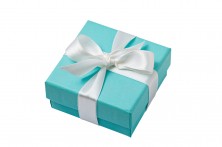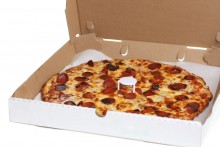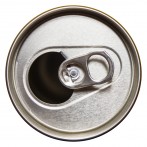1. Heinz Tomato Ketchup

One of the most recognisable products to grace our kitchen cupboards. People have been struggling to get that last bit of sauce out since 1890, yet Heinz ketchup is still a must for meal times the world over, with 650 million bottles sold every year. Despite its squeezy – and some would say more practical – successor, a satisfying slap on the bottom of the original glass bottle will always be fondly remembered.
2. Chanel No 5

The synonymous Chanel No 5 bottle has stood the test of time – neither the packaging nor the scent has changed much since the 1920s. Designed to resemble a whisky decanter, creator Coco Chanel envisioned the bottle to be one of “exquisite, expensive, delicate glass”, and it instantly became a cultural artefact, celebrated by Andy Warhol in the 1980s. Its popularity hasn’t faltered since – it’s still the world’s best-selling perfume with one bottle sold every 30 seconds.
3. Toblerone

A seemingly permanent feature of duty-free shopping, the triangular prism-shaped Toblerone box was not actually inspired by the Swiss Alps’ Matterhorn as most would assume. In fact, the company says creator Theodor Tobler modelled the original design 107 years ago on “something sexier” – dancers at the Folies Bergère in Paris who formed a pyramid at the end of a show.
4. KFC Bargain Bucket

A simple yet iconic design and a classic crowd-pleaser. The Colonel sold his first KFC Bargain Bucket in the late-1950s and it has firmly secured its place on the chain’s menu around the globe. Now seen as a collectors’ item and available for sale on eBay, a vintage bucket could now fetch $50.
5. Heart-shaped chocolate box

The novelty of a heart-shaped chocolate box means it’s still a big seller on Valentine’s Day and instantly recognisable. No matter who the manufacturer is, when people see a red, heart-shaped box, they know what’s inside.
6. Tiffany Blue Box

Crowned with a white satin ribbon tied at the counter, the Tiffany Blue Box, as the company says, is an “international symbol of style and sophistication”. Almost as coveted as the jewellery inside, the trademarked robin’s egg blue boxes can only be obtained with a purchase from the store or by spending a tidy sum on a second-hand one from eBay of Etsy.
7. Pringles

Saving the world from crushed crisps, the unmistakable Pringles tube was an ingenious solution created by designer Fred Baur in 1968 and perfectly houses a neat stack of 100 saddle-shaped Pringles, along with a resealable lid that keep your crisps fresh.
8. Angostura Bitters

No, there wasn’t a mistake at the labelling factory, Angostura intentionally makes its bitters labels too big. The Trinidad-based company puts it down to a “laid-back Caribbean attitude” – legend has it that the person ordering the bottles didn’t think to communicate with the person in charge of the labels.
9. McDonald’s Happy Meal

Few packaging designs are more synonymous with a brand than McDonald’s Happy Meal box. Not that kids needed another reason to eat junk food, savvy marketers from the US chain decided in the late-1970s to tempt children to eat their calorific meals with a toy – something which is still working well for the brand to this day.
10. Coca-Cola
![]()
Despite going through many redesigns over the years, the classic Coca-Cola “contour” bottle created in 1916 is the one we all associate with the fizzy stuff. Renowned as a cultural icon, with its fluted lines to resemble a cocoa pod, and its distinctive, embossed script logo, the bottle definitely fits the original designer’s brief to “develop a container recognisable even if broken on the ground or touched in the dark”.
11. Marmite

Both loved and hated, but recognised by all. Invented by German scientist Justus Von Liebig in the 19th century (before it was even called Marmite), the “food extract” was originally supplied in a marmite – the French term for a crockery casserole dish notable for its pot-belly shape – which inspired the bulbous jar that we all know today.
12. Quality Street

First produced in West Yorkshire in the 1930s, the Quality Street collection tin goes hand in hand with family gatherings and is found on many a coffee table at Christmas – cracking open a tin can bring back a nostalgic whiff of cellophane and chocolate in an instant.
13. Campbell’s Soup

The Campbell’s red-and-white condensed soup can is undeniably iconic, though its fame cannot be attributable to designers at the Campbell Soup Company. Andy Warhol turned this basic aluminium can into an instant cultural sensation in his pop art piece in 1962, making a statement about American popular culture and consumerism, and at the same preserving Campbell’s place in packaging history.
14. Hinged cigarette pack

The hinge-lid hard cigarette pack, created in the 1950s by Desmond Molins, was a major step forward for the tobacco industry as previous soft packs were easily damaged. Used in 1954 to relaunch the Marlboro brand, Molins PLC credits the invention with an instantaneous 50-fold increase in sales for owner Philip Morris International, though designer Frank Gianninoto’s bold red-and-white labelling redesign may have also had something to do with it.
15. Milk carton

Toymaker John Van Wormer got the idea for the first “paper bottle” after smashing a glass milk bottle one morning, and took out a patent in 1915 for the Pure-Pak flat-top carton, though it took him more than ten years to perfect a machine capable of manufacturing on a large scale. Erik Wallenberg of Tetra Pak fame was credited with using less paper and an airtight seal for his tetrahedron design in 1944.
16. Package saver

Carmela Vitale is not a household name, though her 1985 invention of the “package saver” is something everyone can be thankful for – the tiny plastic tripod has saved the world from squashed takeaway pizzas.
17. Wine box

Advertised as a convenient and economical alternative to bottles, bag-in-box wine is having somewhat of a renaissance. Comprised of a (unappetising) plastic bladder and air-tight valve inside a corrugated card container, box wine keeps fresh for up to six weeks, and reduces both packaging waste and carbon emissions compared with glass bottles.
18. Ring pull

Credited as the reason behind a rapid surge in the soft drinks market in the 1960s, Ermal Cleon Fraze from Ohio invented the first detachable ring pull in 1962, saving consumers the need to take a “church key” or can piercer wherever they went. It wasn’t until 1975, when Daniel Cudzik was granted a patent for “stay-tabs” similar to the ones we know today, that the environmental impact of discarded pull tops was addressed.
